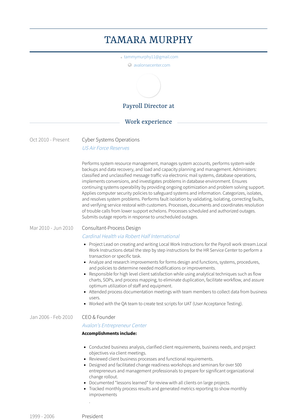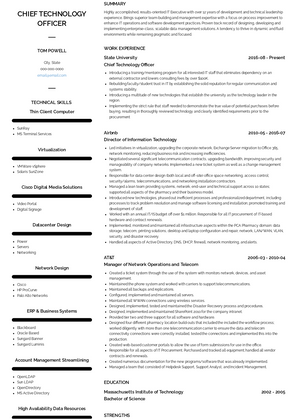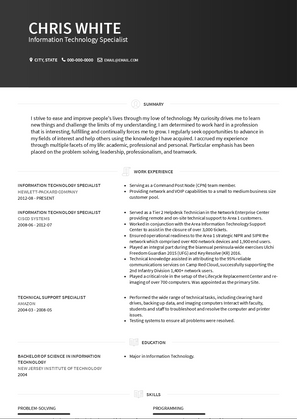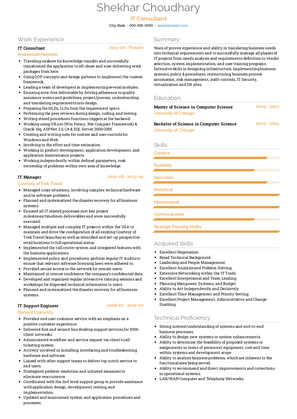Cyber Security Resume Examples + Samples for 2025
This page provides you with Cyber Security Resume Examples + Samples for 2025 resume samples to use to create your own resume with our easy-to-use resume builder. Below you'll find our how-to section that will guide you through each section of a Cyber Security Resume Examples + Samples for 2025 resume.




Overview
Information technology and computing are crucial parts of any business. However, as these amazing technologies become more essential to the way we work, they become greater targets for exploitation and attack. If you have the skills and expertise needed to combat threats from hackers, scammers and viruses, you could find a lucrative and rewarding career in cyber security.
According to the US Bureau of Labor Statistics, cyber security is a fast-growing industry – in fact, job growth for cyber security analysts is estimated at an amazing 35% over the next decade. Even better, you can expect to be paid well for your skills! The median annual wage for cyber security professionals reached $102,600 in the year 2021.
What Do Hiring Managers Look for in a Cybersecurity Resume?
- Hands-on experience with cybersecurity tools and technologies (e.g., firewalls, SIEM, IDS/IPS).
- Demonstrated ability to identify, analyze, and mitigate security threats.
- Certifications such as CISSP, CISM, or CEH.
- Strong problem-solving and incident response skills.
- Knowledge of compliance frameworks like ISO 27001, NIST, or GDPR.
- Experience in implementing and maintaining secure networks.
How to Write a Cybersecurity Resume?
To write a professional Cybersecurity resume, follow these steps:
- Select the right Cybersecurity resume template.
- Write a professional summary that highlights your cybersecurity expertise, achievements, and certifications.
- Include a section detailing your hands-on experience in securing systems, networks, and data.
- Follow the STAR method to describe your work experience, focusing on security improvements and incident responses.
- Highlight technical skills such as penetration testing, vulnerability management, and encryption in a dedicated skills section.
- Include education, certifications, and training relevant to cybersecurity.
How to Write Your Cybersecurity Resume Header?
Write the perfect Cybersecurity resume header by:
- Adding your full name prominently at the top.
- Including a professional photo if it aligns with industry norms in your region.
- Adding your current or most recent cybersecurity role title.
- Providing contact information: city, phone number, professional email address, and a LinkedIn or GitHub profile link.
Bad Cybersecurity Resume Example - Header Section
John Doe 123 Secure St. Email: hackspecialist@email.com, Instagram: @cyberking123
Good Cybersecurity Resume Example - Header Section
John Doe, San Francisco, CA, Phone: +1-555-555-5555, Email: john.doe@email.com, LinkedIn: linkedin.com/in/johndoe, GitHub: github.com/johndoe
How to Write a Professional Cybersecurity Resume Summary?
Use this template to craft a compelling Cybersecurity resume summary: "Cybersecurity Professional with [number of years] years of experience in [specific areas, e.g., network security, threat intelligence]. Expert in [key skills, e.g., intrusion detection, vulnerability assessments]. Proven success in [key achievement or project]."
Examples:
- "Cybersecurity Analyst with 5+ years of experience in threat detection and mitigation. Expert in SIEM tools and risk assessments. Reduced incident response time by 30% through optimized detection workflows."
- "Certified Cybersecurity Specialist with 8 years of experience in network security and compliance frameworks. Successfully implemented a zero-trust model, reducing data breaches by 40%."
How to Write a Cybersecurity Resume Experience Section?
Here’s how to structure an impactful Cybersecurity resume experience section:
- Present work experience in reverse chronological order.
- Use bullet points for clarity, focusing on security responsibilities and outcomes.
- Quantify achievements wherever possible (e.g., mitigated 300+ threats, improved system uptime by 20%).
- Emphasize technical expertise, incident response, and strategic implementations.
- Use action verbs such as "Secured," "Mitigated," "Implemented," or "Monitored."
Cybersecurity Resume Example
Cybersecurity Analyst
- Monitored network traffic and mitigated over 250 cybersecurity threats annually.
- Conducted vulnerability assessments, resulting in a 15% reduction in system risks.
- Developed and implemented security protocols that improved compliance with NIST standards.
Security Engineer Resume Example
Security Engineer
- Designed and implemented a SIEM solution, reducing response time to incidents by 40%.
- Conducted penetration testing to identify and remediate system vulnerabilities.
- Collaborated with cross-functional teams to ensure secure application development.
Additional Sections for a Cybersecurity Resume
- Certifications (e.g., CISSP, CISM, CEH, CompTIA Security+)
- Technical Projects and Tools
- Awards and Recognitions
- Languages (if applicable)
- Professional Memberships (e.g., ISACA, ISC²)
Top Cybersecurity Resume Skills for 2025
- Network Security
- Penetration Testing
- Vulnerability Assessment
- Threat Intelligence
- Encryption Techniques
- SIEM Tools (e.g., Splunk, QRadar)
- Compliance Frameworks (ISO 27001, NIST, GDPR)
- Incident Response
- Risk Management
- Cloud Security
Certifications to Highlight in a Cybersecurity Resume
Certifications are a critical component of a cybersecurity resume, as they validate your expertise and commitment to the field.
- Key Certifications to Include:
- Certified Information Systems Security Professional (CISSP)
- Certified Information Security Manager (CISM)
- Certified Ethical Hacker (CEH)
- CompTIA Security+
- Offensive Security Certified Professional (OSCP)
Example Entry: “Certified Ethical Hacker (CEH), EC-Council – Valid through 2026.”
Professional Memberships for a Cybersecurity Resume
Professional memberships show your dedication to staying updated with industry trends and standards.
- Key Associations:
- ISACA
- (ISC)²
- SANS Institute Alumni
- Cloud Security Alliance (CSA)
Example Entry: “Active member of ISACA, participating in monthly workshops and professional development programs.”
Achievements and Metrics in a Cybersecurity Resume
Employers value measurable achievements that demonstrate your impact in previous roles.
- Examples:
- “Monitored network traffic and mitigated 500+ cybersecurity threats annually, ensuring 99.9% uptime.”
- “Reduced data breach incidents by 40% through the implementation of zero-trust architecture.”
- “Conducted penetration tests that identified and resolved 200+ vulnerabilities.”
Career Progression to Highlight in a Cybersecurity Resume
Demonstrate your growth in the cybersecurity field by showing advancements in roles and responsibilities.
- Example Entry: “Cybersecurity Analyst, XYZ Corp (20XX-Present): Promoted from Junior Analyst after achieving a 20% reduction in security incidents through improved monitoring protocols.”
Industry-Specific Experience for a Cybersecurity Resume
Cybersecurity practices differ across industries. Tailor your resume to highlight relevant experience.
- Examples by Industry:
- Finance: “Secured customer financial data by implementing multi-factor authentication, reducing fraud cases by 15%.”
- Healthcare: “Ensured compliance with HIPAA regulations by auditing and securing patient data systems.”
- Retail: “Protected e-commerce platform by deploying a Web Application Firewall (WAF), reducing unauthorized access by 30%.”
Technical Projects to Include in a Cybersecurity Resume
Projects demonstrate hands-on experience and technical skills. Include projects that are relevant to the role you’re applying for.
- Examples:
- “Developed a custom SIEM solution for a mid-sized enterprise, enhancing threat detection capabilities by 50%.”
- “Designed a phishing simulation program to train employees, resulting in a 60% reduction in phishing incidents.”
How to Showcase Compliance Knowledge in a Cybersecurity Resume
Knowledge of compliance frameworks is crucial for roles that require adherence to regulatory standards.
- Examples:
- “Implemented NIST Cybersecurity Framework to strengthen enterprise security posture.”
- “Conducted GDPR compliance audits, reducing potential regulatory fines by $100,000.”
Education and Training for a Cybersecurity Resume
Your education and training form the foundation of your cybersecurity expertise.
- Key Details to Include:
- Degrees in Cybersecurity, Computer Science, or Information Systems
- Specialized training programs from institutions like SANS or Cybrary
Example Entry: “Bachelor of Science in Cybersecurity, ABC University – Graduated 2020.”
How to Emphasize Threat Intelligence Expertise in a Cybersecurity Resume
Threat intelligence expertise showcases your ability to proactively identify and respond to security risks.
- Examples:
- “Analyzed threat intelligence feeds to preempt ransomware attacks, safeguarding $5M in enterprise assets.”
- “Deployed advanced threat detection tools, identifying 30+ potential vulnerabilities monthly.”
How Long Should My Cybersecurity Resume Be?
Cybersecurity resumes typically range from one to two pages. Focus on technical expertise, certifications, and measurable outcomes to create a concise and impactful document.
For assistance, consider using our resume builder or explore Cybersecurity resume examples to get started.
Copyright ©2025 Workstory Inc.
